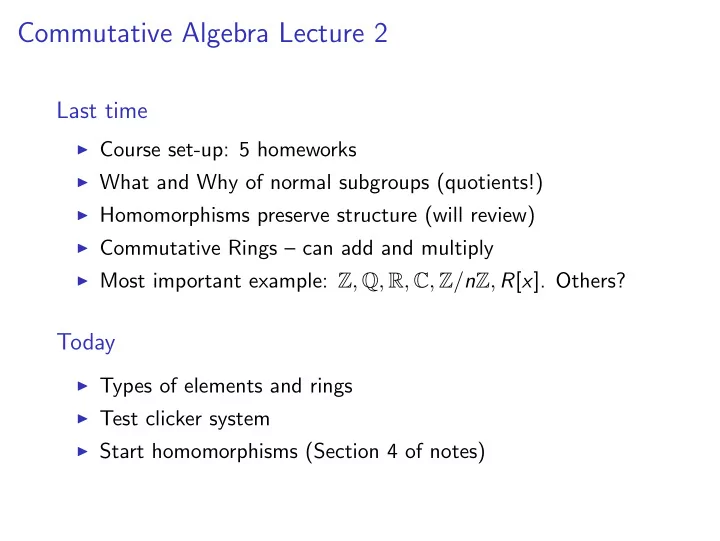

Commutative Algebra Lecture 2 Last time ◮ Course set-up: 5 homeworks ◮ What and Why of normal subgroups (quotients!) ◮ Homomorphisms preserve structure (will review) ◮ Commutative Rings – can add and multiply ◮ Most important example: Z , Q , R , C , Z / n Z , R [ x ]. Others? Today ◮ Types of elements and rings ◮ Test clicker system ◮ Start homomorphisms (Section 4 of notes)
Looking into the future ◮ The last HW question depends on Section 4 ◮ Next session we will finish Section 4, motivate 5 and 6 ◮ After that, roughly one section / lecture Before next week’s lecture... ◮ Read Sections 2-4 of the notes ◮ Email me questions / comments you have about them The first Homework is due October 18th!
Basic definitions: types of elements Definition We say r ∈ R is a unit if there exists an element s ∈ R with rs = 1 R Definition We say that r ∈ R is a zero divisor if there exists s ∈ R , s � = 0 R with rs = 0 R Definition We say that r ∈ R is nilpotent if there exists some n ∈ N with r n = 0 R Examples!
Basic definitions: Types of rings Definition We say R is field if every nonzero element is a unit. By convention, the trivial ring is not a field. Definition We say R is an integral domain if it has no zero divisors. Definition We say that R is reduced if it has no nilpotent elements. Examples! Theorem R a field = ⇒ R an integral domain = ⇒ R is reduced
Clicker session: ttpoll.eu
Review: (Homo)-morphisms preserve structure Objects Often in math we study things that are sets with some extra sturcture (Groups, rings, fields, vector spaces, metric spaces, topological spaces, measure space, . . . ). Maps or Morphisms In these situations, usually there is a notion of map or morphism between these objects – these are functions that “preserve the extra structure” ◮ Group homomorphisms preserve addition, units, inverses ◮ Vector space morphisms (linear maps) preserve addition and multiplication by scalars
What do we mean by “preserve structure”? More specifically, recall that a group G has: ◮ an identity e ◮ a multiplication map G × G → G : ( g , h ) �→ g · h ◮ an inverse map G → G : g �→ g − 1 . Definition A group homomorphism ϕ : G → H is a map of sets so that 1. ϕ ( e G ) = e H 2. ϕ ( g − 1 ) = ϕ ( g ) − 1 3. ϕ ( g 1 · g 2 ) = ϕ ( g 1 ) · ϕ ( g 2 ) Warning: For us, “preserve the structure” doesn’t have to be this striaghtforward.
What is a ring homomorphism?
Ring Homomorphisms Definition A ring homomorphism ϕ : R → S is a function so that 1. ϕ (0 R ) = 0 S 2. ϕ (1 R ) = 1 S 3. ϕ ( − r ) = − ϕ ( r ) 4. ϕ ( r + s ) = ϕ ( r ) + ϕ ( s ) 5. ϕ ( rs ) = ϕ ( r ) ϕ ( s ) This is slightly more involved than the definition in the notes, because some of these properties follow from others... Which?
Examples of ring homomorphisms!
Recommend
More recommend